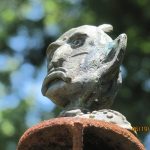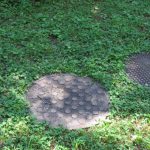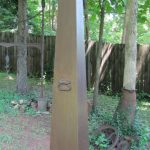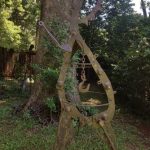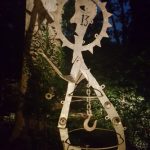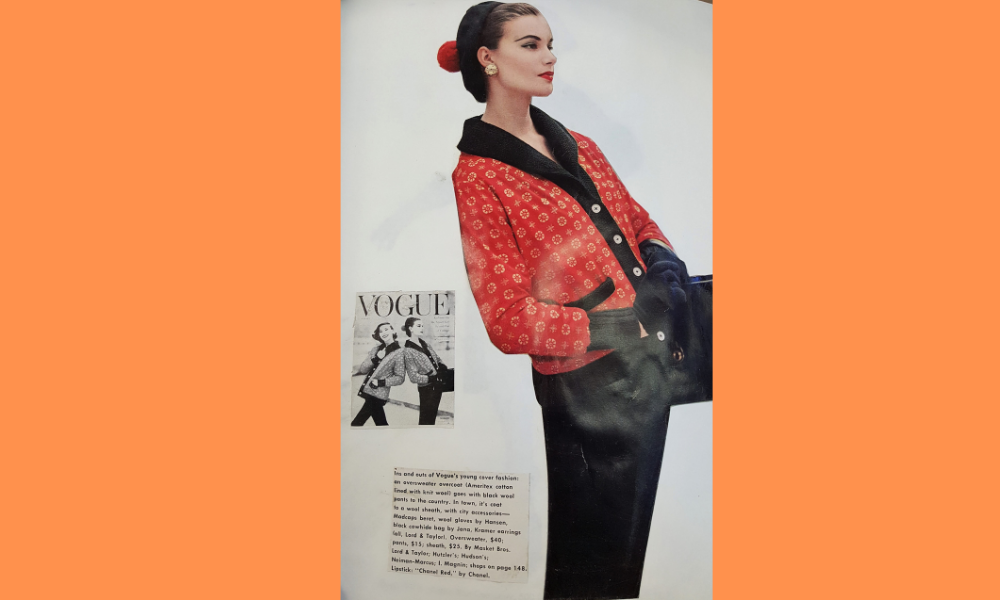Druid Hill: Clark Ashton’s Sculpture Gallery
Clark Ashton’s sculptures sit dramatically on Druid Hill. His Commuter Gallery is perched 30 feet above North Druid Hills Road. He is passionate and fully immersed in his art. He talks with the gusto of a street preacher paired with the mind of a grassroots organizer.
Written by DHC Intern Samantha Mooney
“Art wasn’t supposed to look nice; it was supposed to make you feel something.” – Rainbow Rowell, Eleanor & Park
Clark Ashton remembers the first time he saw him. There was a man who wore the three-piece white suit; he would hang out on the street corner, swinging a gold chain. To a young Ashton, this man was fascinating. The man who fearlessly stood out in the small town of Augusta, Georgia. He was unique, inimitable.
For a new generation, Ashton has become a similar figure, “that strange man over on Druid Hills road.” Each year, for the past twenty-four years, he has sat on a throne in his front yard, waving at local school children who are trapped in morning traffic. He is trying to show kids that it is okay to be different, that people can prosper in alternative lifestyles. In his view, independent thought and action are increasingly important in a highly regimented society. Most people react favourably, but a few laugh or yell. It doesn’t bother him. Ashton believes in what he is doing.
Ashton was not always this way. Once, in the distant, past, he held a normal job. When he became unemployed, it allowed him to stop and say ‘What am I doing with my life [and] what do I want to do?” He had always been creative, but recent comprises within his band made him frustrated. He needed a different artistic outlet.

Pictured is Clark Ashton’s shop with his scrap metal, tools, and artistic works that are in progress (Samantha Mooney)
Earlier, in high school, he had learned how to weld. In his small town, there weren’t many options. People went to college, which Ashton’s family could not afford, or worked. Jobs such as welding paid well, so he learned the trade; later in his life, Ashton put these skills to use. He had no formal art training, but his physical space was inspirational. His property, which sat on a hill, is perched thirty feet higher than the street. It seemed only natural that the hill could become a stage, the site of a battle with “men charging up the hill with swords and other people with spears. At the top, there could be a big fight.”
Art grounded Ashton. He “realized that this was what [he] needed to do with [his] time.” He began creating metal men. The first was Adam, titled “uncreatively” after the biblical first man. More followed, encompassing a variety of subjects. Some were nudes. Others touched on themes that would reoccur in Ashton’s future works. Bagman shows a slumped figure, hunched over a shopping cart, pushing it eternally, a direct critique of capitalism and endless consumerism. Ashton’s art, by his own assessment, “is about God and money, essentially.”
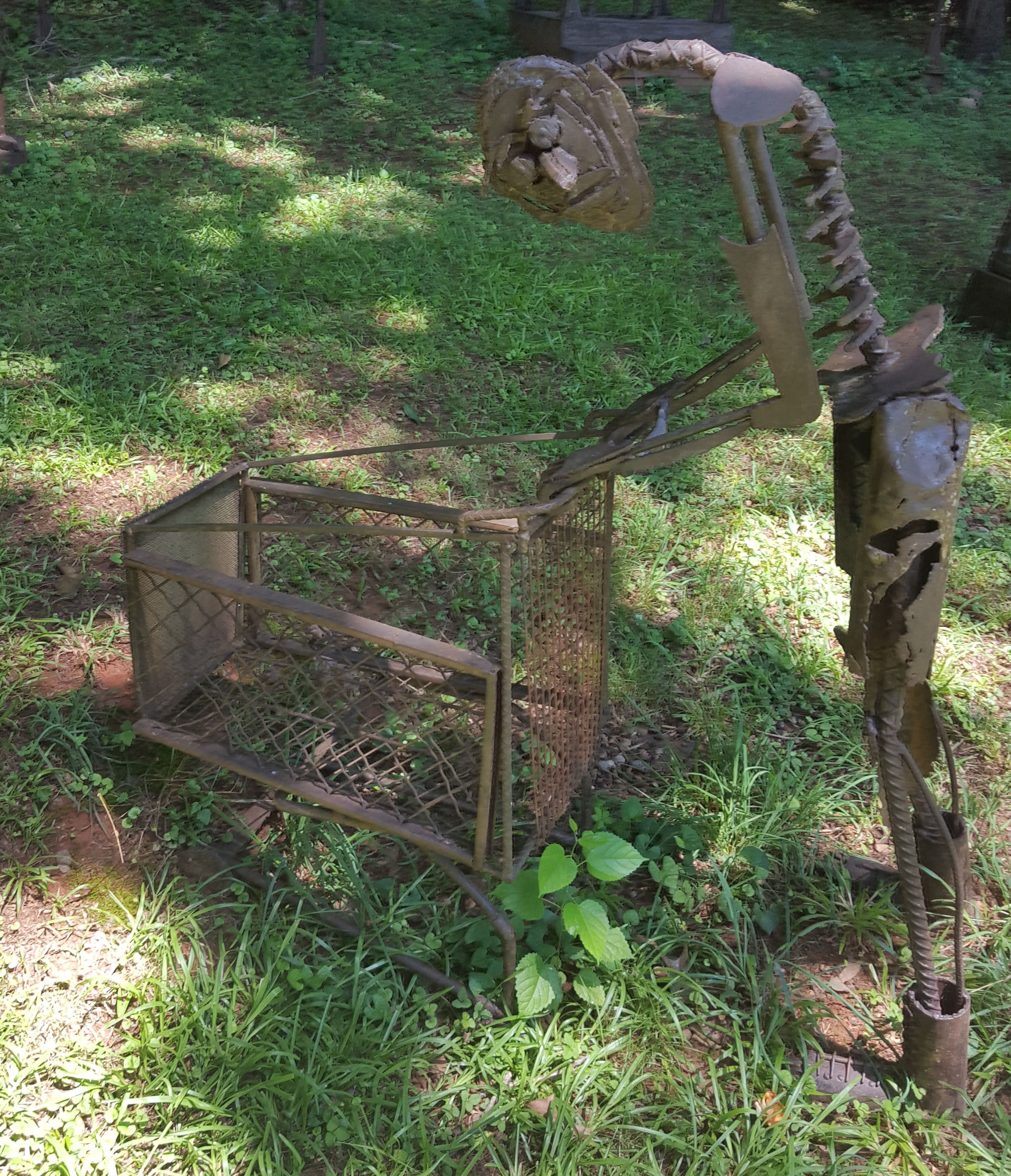
Ashton’s “Bagman” shows a dishevelled figure posed over a shopping cart (Samantha Mooney)
Eventually, Ashton began a more formalized education, focusing on anthropology and sculpture, to support his artistic aims. Anthropology helped him tease out the larger themes in his work. He was intrigued by belief systems, wanting to know “why people think what they do? Why do they believe something to the degree that they will kill other people?”
Ashton’s pieces respond to these questions, interrogating capitalism and belief systems. Thematically, they have elements of various philosophies: the alienated labor of Marx, the existentialism of Sartre, and symbology adopted from assorted early Fertile Crescent religions.
Ashton is passionate and fully immersed in his art. He talks with the gusto of a street preacher paired with the mind of a grassroots organizer. He attempts to rally people and invites them to engage with his works. He challenges viewers to look at broad concepts such as capitalism in new ways.
Despite the ease which he discusses his complex ideology, Ashton didn’t comprehend the symbology behind his pieces until they were completed. He was just making pieces that looked cool. Yet, once he had made the commitment, the meaning gradually became clear. Ashton says “if you just roll with it until it comes together, you don’t know where it’s going, you don’t know what happy accidents are going to occur along the way, you don’t know what dream you [will] have… you don’t know what [the] multiple elements mean [until] they come together. ”
—
The road winds below like a sinuous grey river, ferrying along commuters encased in their individual bubbles. Some look agitated, anxious as they rush to carry out the daily necessities of a modern life. Some look curious, peering at the looming metal sculptures, gawking blatantly. The effect that the sculptures have is nearly indescribable. The road is generally mind-numbingly, a monotonous journey with the vaguely ranch-esque homes blending together. Then a visual feast for the eyes emerges.

Ashton’s front yard features the Commuter Gallery which Boundary encloses. The installation attempts to harvest souls and manufacture psychic unity using industrial tools that we are familiar with in modernity (Samantha Mooney)
- The Artist Clark Ashton
- Vulture Detail on “Boundary”
- Head Detail on “Boundary”
Metal soars through the sky. The installation in the front yard is the Commuter Gallery, comprised of several works. Massive tools, common in our industrial world, are used to manufacture psychic unity. Boundary, which ensconces the three towers in the front yard, is a figurative, liminal space, separating Ashton’s home, peaceful and comfortable, from the constant bustle of place always in flux. It is thick with symbology: the bottom represents the past, both physical and spiritual, the mid-section the present, and the top is the future waiting “the imminent demise of lives, people, places and things.” Past, present, and future are linked together through the chain of life and DNA helixes climbing up the poles, transmitting information. The throne serves as a bridge between the home environment and the chaos of a world constantly in flux. Ashton tries to create community in a world that has become increasingly transient.
What is fascinating is how the piece functions on many levels. The first is the most evident. The commuters peer up at the gallery, at the sudden disruption in the landscape. Yet, the second and the most clever is that gallery viewers look down at the commuters who serve as an element of the installation. They are an example of what Ashton seeks to convey: how we are limited by societal structures, unable to escape them. His artwork questions these everyday norms. Ashton believes that “[our] anxiety is brought by the cognizance of our mortality.” We all want to know where do we come from and why are we here? In Ashton’s view, “we build belief systems so that we can answer these questions.”
- Sewer and manhole covers serve as garden pavers
- “Mobilisk” invites questions about monuments
- Ashton’s “Kingdom Come” is a smaller, portable version of “Boundary”
Ashton’s keen mind expresses itself in clever ways. One piece, Kingdom Come, is a portable version of Boundary with a more elaborate throne, made to connect with the spiritual realm.
A personal favorite of mine is Mobilelisk, a direct commentary on the changing natures of symbols. Historically, cultures across the globe have been co-opted by the conquerors. Imperialism and colonialism meant that local symbols were stolen and often refashioned into monuments. Due to this, the obelisk is lightweight and mobile, featuring handles to move it around and place it where the viewer wishes to. It’s almost metatextual, encapsulating debates that are still ongoing around monuments and symbology in American culture.
Ashton’s sculptures mix up multiple dichotomies. Most of them are made of found scrap giving them an aged patina that would be difficult to replicate; yet they are recontextualized, reworked into new forms. Manhole covers become garden pavers, a whimsical transformation that causes a double-take. They are old and new simultaneously, standing in the middle of the verdant green grass, a ‘Sewer Brick Road.’
Some of them are abstract, straight linear lines, guiding the mind to imagine. Others are almost cartoonish and slightly impish. Ashton may be unorthodox, but his approach is grounded with an understanding of classical art. No statue underlies this point more than Contrapposto. Based on the Greek tradition, it portrays a figure in repose. If Ashton flaunts convention, it is by choice.
In many ways, Ashton is the antithesis of the commercial art world. His installations are free, open to the public, and can be visited on a whim. There is something distinctly populist about his approach. None of the objects are put on a pedestal: there is no given interpretation, no placards that tell viewers how to think about the pieces. The one exception, The Battle of Druid Hill, places Ashton as an “eyewitness, man on the street [observing] real-time history.” The open-air nature of Druid Hill means that visitors can meander around, setting the terms of their engagement. There’s much to explore, and each visit, it’s easy to find some new fascination.
- “The Flight of Number 13” at day
- “The Flight of Number 13” at night
Even the time of day changes the interplay of the art. At night, lights illuminate certain parts, giving them a new life. The figure on the bike seems in Cyclist poised, paused before a moment of freedom; on a second look, maybe the figure is terrified, throwing their hands up before the moment of impact. It’s difficult to tell. The art, as usual, embraces duality. The two skeletons in Dance of the Dead look both eerie and softer, almost jolly in the diffused light. The Flight of Number 13 casts a long shadow, creating a secondary figure, almost like a twin, barely sketched out.
Like all the best art, it’s also a little mad. In ancient Greece, mania was associated with creativity, a divergence from ordinary rationality and convention. In Plato’s understanding, art, specifically, sprang from divinely inspired mania, enabled the artist to accomplish beyond what was ordinarily possible.
This is the framework that contextualizes Ashton’s work. His pieces have an astonishing variety. Some are so large that they loom ominously, requiring a crane and scaffolding to construct. The Superstructure took five years to create. Others are no bigger than the head of a shovel but are intricately detailed. The sheer magnitude of Druid Hill can sometimes be overwhelming, necessitating the time to slow down and take it all in. It’s the best kind of madness, requiring intense love and passion, that few of us would be capable of. It’s also the stuff of dreams, an undeniable personal triumph that Clark Ashton has crafted with his own two hands. Over on North Druid Hills Road, the kingdom of dreams and madness continues to take shape.
Druid Hill is located at 3162 N. Druid Hills Rd, Decatur, GA.
Written by Samantha Mooney
Works Cited
Rowell, Rainbow. Eleanor & Park. New York, NY: St. Martin’s Press.
Mooney, Samantha. Interview with Clark Ashton. Mechanical Riverfront Kingdom [Decatur], June 19, 2018.
Plato. Plato’s Phaedrus. Cambridge: University Press, 1952.




